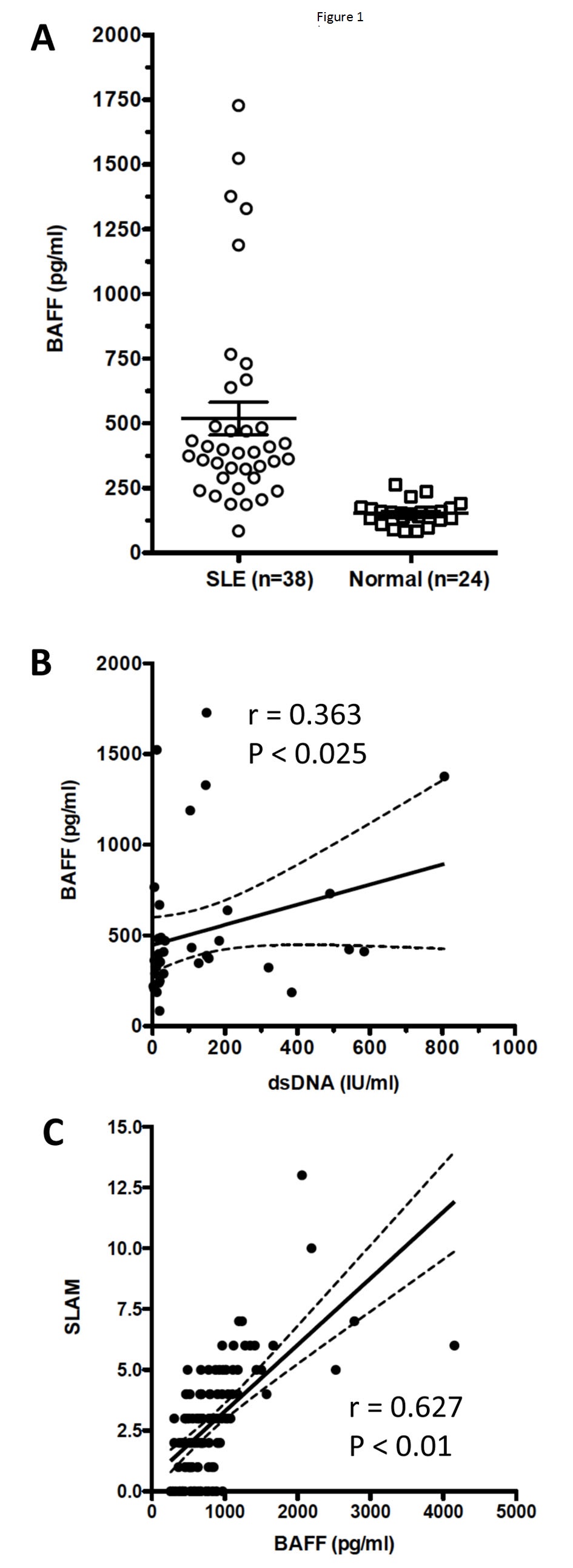Session Information
Date: Tuesday, November 15, 2016
Title: Systemic Lupus Erythematosus – Clinical Aspects and Treatment - Poster III: Biomarkers and Nephritis
Session Type: ACR Poster Session C
Session Time: 9:00AM-11:00AM
Background/Purpose: B cell activating factor (BAFF) is implicated in the pathogenesis of systemic lupus erythematosus (SLE). A previous small scale study reported that endogenous neutralizing serum anti-BAFF autoantibodies were found in higher levels in SLE patients compared to healthy subjects, and were associated with increased SLE disease severity. We sought to evaluate levels of BAFF and endogenous autoantibodies to BAFF in our oriental SLE cohort, and to determine their correlation with disease activity.
Methods: Serum BAFF and anti-BAFF IgG antibody levels were first assayed in 38 SLE patients and 24 healthy controls by ELISA. Correlation of serum BAFF and anti-BAFF IgG levels with disease activity scored by SLAM-R was determined in a larger cohort of 121 patients. The 121 SLE patients were predominantly female (85.9%), mean age 38.7±12.4 years, mean disease duration 102±89 months; and comprised 80.9 %( 98) Chinese, 11.6 %( 14) Malay, and 7.4% (9) Indian and other ethnicity; mean SLAM-R score and SDI of 2.8±2.2 and 0.6±0.97 respectively . SLE disease manifestations at the time of sample assay included mucocutaneous in 7(5.8%), fatigue in 4(3.3%), active urine sediment in 33(27.3%), hypocomplementemia in 88(72.7%), and raised anti-dsDNA antibody titres in 80(66.1%). The majority were on corticosteroids (72.7%) and hydroxychloroquine (67.8%). Immunosuppressive drugs included azathioprine in 35.5%, mycophenolate in 5.8%, and intravenous pulse cyclophosphamide in 3.3%.. SLE patients all fulfilled 1997 revised ACR classification criteria.
Results: Serum BAFF was elevated in SLE patients compared to controls; mean 1615pg/ml and 338pg/ml, respectively (p<0.01)(Fig 1A); and correlated with anti-dsDNA antibody levels (r=0.363, p=0.025)(Fig 1B), and SLAM-R scores(r=0.615, p<0.01; n=121)(Fig 1C). Significantly higher levels of anti-BAFF IgG were found in over 80% of SLE patients (N/200-3200 serial dilution)(Fig 2A), which correlated negatively with SLAM-R (r=-0.4161, p<0.01; n=121)(Fig 2C), and levels of antidsDNA (r=-0.335, p=0.039)(Fig 2B) and BAFF(r=-0.459, p=<0.01).
Conclusion: Elevated levels of anti-BAFF autoantibodies were found in over 80% of our oriental SLE patients in negative correlation with clinical disease activity, antidsDNA and BAFF levels. Our findings provide further information about the complexity of BAFF pathophysiology in different SLE disease populations and phenotypes, and may have implications in the selection of patients for the development and utilisation of anti-cytokine therapies.
To cite this abstract in AMA style:
Howe HS, Thong B, Kong KO, Chng HH, Lian TY, Chia F, Tay K, Lau TC, Law WG, Koh ET, Leung BPL. Associations of BAFF and Anti-BAFF Autoantibodies with Disease Activity in Oriental Systemic Lupus Erythematosus [abstract]. Arthritis Rheumatol. 2016; 68 (suppl 10). https://acrabstracts.org/abstract/associations-of-baff-and-anti-baff-autoantibodies-with-disease-activity-in-oriental-systemic-lupus-erythematosus/. Accessed .« Back to 2016 ACR/ARHP Annual Meeting
ACR Meeting Abstracts - https://acrabstracts.org/abstract/associations-of-baff-and-anti-baff-autoantibodies-with-disease-activity-in-oriental-systemic-lupus-erythematosus/


